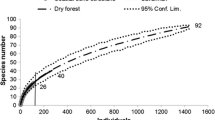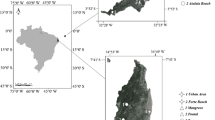Abstract
Although large islands generally support a richer insect fauna than small islands, many large islands, which are more often inhabited, have lost numerous species because of human activities and introduced organisms. To clarify the consequences of endemic insect conservation on small islands near inhabited islands, we compared the species richness, abundance, and composition of two beetle groups (Coleoptera: Cerambycidae and Mordellidae) captured using Malaise traps among three islands (Chichijima, 24.0 km2; Anijima, 7.85 km2; Nishijima, 0.49 km2) in the oceanic Ogasawara (Bonin) Island group in the northwestern Pacific during June–July 2006 and 2007. Chichijima, the largest island, is inhabited, while Anijima and Nishijima are not. The numbers of cerambycid and mordellid species previously recorded were positively correlated with island area. However, the total numbers of cerambycid and mordellid species we captured in Malaise traps were not correlated with island area because we were unable to collect many species previously documented on Chichijima. The numbers of cerambycid and mordellid species per trap did not differ significantly among islands and years, although the deviance was well explained by the island variable. We captured greater numbers of cerambycid and mordellid individuals on Chichijima than on Anijima and Nishijima, and the numbers of cerambycid and mordellid individuals per trap significantly differed among islands and between years. Redundancy analysis (RDA) showed that the species composition of cerambycids and mordellids differed among the three islands. Whereas endangered species were rarely captured on Chichijima, alien or non-endemic species were frequently collected. Cerambycid and mordellid beetles on Chichijima may have been deleteriously affected by recent forest disturbance and introduced organisms. Therefore, conserving insect fauna on uninhabited island “refugia” is important for preserving the insect diversity of the Ogasawara Islands.




Similar content being viewed by others
References
Abe T, Makino S, Okochi I (2008) Why have endemic pollinators declined on the Ogasawara Islands? Biodivers Conserv 17:1465–1473. doi:10.1007/s10531-008-9355-y
Basilewsky P (1985) The south Atlantic island of Saint Helena and the origin of its beetle fauna. In: Ball BE (ed) Taxonomy phylogeny and zoogeography of beetles and ants. Dr W Junk Publishers, The Hague, pp 257–275
Bates D (2007) The lme4 Ver. 0.99875-9 R Package. http://www.r-project.org/
Borges PAV, Cunha R, Gabriel R, Martins AF, Silva L, Vieira V (eds) (2005) A list of terrestrial fauna (Mollusca and Arthropoda) and flora (Bryophyta, Pteridophyta and Spermatophyta) from the Azores. Direccão Regional do Ambiente and Universidade dos Acores, Horta, Angra do Heroísmo and Ponta Delgada
Carlquist S (1974) Island biology. Columbia University Press, New York
Faraway JJ (2006) Extending the linear model with R. Chapman & Hall, Boca Raton
Gaston KJ (2003) Rates of species introduction to a remote oceanic island. Proc R Soc Lond B Biol Sci 270:1091–1098. doi:10.1098/rspb.2003.2332
Gillespie RG, Roderick GK (2002) Arthropods on islands: colonization, speciation, and conservation. Annu Rev Entomol 47:595–632. doi:10.1146/annurev.ento.47.091201.145244
Hatayama T, Takakuwa M (1985) Mordellidae: Mordellistenini. In: Kurosawa Y, Hisamatsu S, Sasaji H (eds) Coleoptera of Japan in color, vol 3. Hoikusha, Osaka, Japan, pp 387–397 [incl pl 67] (In Japanese)
Hilburn D, Gordon RD (1989) Coleoptera of Bermuda. Fla Entomol 72:673–692. doi:10.2307/3495046
Hogue CL, Miller SE (1981) Entomofauna of Cocos Island, Costa Rica. Atoll Res Bull 250:1–29
Holland JD (2007) Sensitivity of Cerambycid biodiversity indicators to definition of high diversity. Biodivers Conserv 16:2599–2609. doi:10.1007/s10531-006-9066-1
Jackman JA, Lu W (2002) Mordellidae Latreille 1802. In: Arnett RH Jr, Thomas MC, Skelley PE, Frank JH (eds) American beetles, Volume 2. Polyphaga: Scarabaeoidea through Curculionoidea. CRC Press, Boca Raton, pp 423–430
Kami KS, Miller SE (1998) Samoan insects and related arthropods: checklist and bibliography. Bishop Museum Technical Report No. 13, Bishop Museum Press, Honolulu
Karube H (ed) (2004) Changing insect fauna in Ogasawara: report on an oceanic island ecosystem influenced by human impacts. Res Rep Kanagawa Pref Mus Nat Hist 12:1–88 (In Japanese)
Kato M (1992) Endangered bee fauna and its floral hosts in the Ogasawara Islands. Jpn J Entomol 60:487–494
Kato T, Kitajima H, Makihara H (1998) Coleopterous insects collected by the Malaise Trapping Method at various stands in Chichijima Is. and Hahajima Is. of Ogasawara Islands. Proc Kanto Conf Jpn For Soc 49:61–64 (In Japanese)
Leps J, Smilauer P (2003) Multivariate analysis of ecological data using CANOCO. Cambridge University Press, Cambridge
MacArthur RH, Wilson EO (1967) The theory of island biogeography. Princeton University Press, Princeton
Maeto K, Makihara H (1999) Changes in insect assemblages with secondary succession of temperate deciduous forests after clear-cutting. Jpn J Entomol NS 2:11–26 (In Japanese with English summary)
Makihara H, Kitajima H, Goto H, Kato T, Makino S (2004) An evaluation of predation impact on the introduced lizard Anolis carolinensis on the endemic insect fauna of the Ogasawara Islands based on insect collection records and feeding experiments, with special reference to longicorn beetles (Insecta: Coleoptera: Cerambycidae). Bull For For Prod Res Inst 3:165–183 (In Japanese with English summary)
Makino S, Goto H, Hasegawa M, Okabe K, Tanaka H, Inoue T et al (2007) Degradation of longicorn beetle (Coleoptera, Cerambycidae, Disteniidae) fauna caused by conversion from broad-leaved to man-made conifer stands of Cryptomeria japonica (Taxodiaceae) in central Japan. Ecol Res 22:372–381. doi:10.1007/s11284-007-0359-y
Ministry of the Environment of Japan (2007) Red Data Book for Japan. http://www.env.go.jp/press/file_view.php?serial=9956&hou_id=8648
Motala SM, Krell F-T, Mungroo Y, Donovan SE (2007) The terrestrial arthropods of Mauritius: a neglected conservation target. Biodivers Conserv 16:2867–2881. doi:10.1007/s10531-006-9050-9
New TR (2008) Insect conservation on islands: setting the scene and defining the needs. J Insect Conserv 12:197–204. doi:10.1007/s10841-008-9159-0
Nishida GM (ed) (2002) Hawaiian terrestrial arthropod checklist, 4th edn. Bishop Museum Technical Report 22, Bishop Museum Press, Honolulu
Nishida GM (2007) French Polynesia beetle checklist (preliminary). http://essigdb.berkeley.edu/checklists/
Nomura S (1975) Mordellidae of Bonin Islands (Coleoptera). Entomol Rev Jpn 28:29–45 pl 5
Ohbayashi N, Nisato T (eds) (2007) Longicorn beetles of Japan: manual with keys and illustrations. Tokai University Press, Hatano (In Japanese)
Ohbayashi T, Inaba M, Suzuki H, Kato M (2003) List of insects in Ogasawara Islands, Japan (2002 ver). Ogasawara Res 29:17–74 In Japanese
Ohsawa M (2004) Species richness of Cerambycidae in larch plantations and natural broad-leaved forests of the central mountainous region of Japan. For Ecol Manag 189:375–385
Peck SB (2006) The beetles of the Galápagos Islands, Ecuador: evolution, ecology and diversity (Insecta: Coleoptera). NRC Research Press, Ottawa
R Development Core Team (2006) R: a language and environment for statistical computing. R Foundation for Statistical Computing, Vienna
Samways MJ (2005) Insect diversity conservation. Cambridge University Press, Cambridge
Shimizu Y (2003) The nature of Ogasawara and its conservation. Glob Environ Res 7:3–14
Simberloff D (1974) Equilibrium theory of island biogeography and ecology. Annu Rev Ecol Syst 5:161–182. doi:10.1146/annurev.es.05.110174.001113
Sugiura S, Abe T, Yamaura Y, Makino S (2007) Flower-visiting behavior of male bees is triggered by nectar-feeding insects. Naturwissenschaften 94:703–707. doi:10.1007/s00114-007-0246-y
Sugiura S, Tsuru T, Yamaura Y, Hasegawa M, Makihara H, Makino S (2008a) Differences in endemic insect assemblages among vegetation types on a small island of the oceanic Ogasawara Islands. Entomol Sci 11:131–141. doi:10.1111/j.1479-8298.2008.00263.x
Sugiura S, Yamaura Y, Makihara H (2008b) Biological invasion into the nested assemblage of tree-beetle associations on the oceanic Ogasawara Islands. Biol Invasions 9:1061–1071. doi:10.1007/s10530-007-9184-z
ter Braak CJF, Smilauer P (2002) CANOCO reference manual and CanoDraw for windows user’s guide: software for canonical community ordination (ver 4.5). Microcomputer Power, Ithaca
Toyoda T (2003) Flora of Bonin Islands (enlarged and revised). Apoc, Kamakura, Japan (In Japanese)
Whittaker RJ (1998) Island biogeography: ecology, evolution and conservation. Oxford University Press, Oxford
Wood SN (2006) Generalized additive models: an introduction with R. Chapman & Hall, Boca Raton
Zamora II, Esquivel JLM, Pérez NZ, Hernández MA (eds) (2004) Lista de especies silvestres de Canarias: hongos, plantas y animales terrestres. Banco de Datos de Biodiversidad de Canarias
Acknowledgments
We thank the staff of the National Forest Division of the Ogasawara General Office for permission to use the study sites. We thank J. Minami for boat transportation to Anijima and Nishijima and K. Ogasawara for helping with the fieldwork. This study was funded by the Japanese Ministry of the Environment (Global Environmental Research Coordination System and Global Environmental Research Fund F-051).
Author information
Authors and Affiliations
Corresponding author
Rights and permissions
About this article
Cite this article
Sugiura, S., Tsuru, T., Yamaura, Y. et al. Small off-shore islands can serve as important refuges for endemic beetle conservation. J Insect Conserv 13, 377–385 (2009). https://doi.org/10.1007/s10841-008-9185-y
Received:
Accepted:
Published:
Issue Date:
DOI: https://doi.org/10.1007/s10841-008-9185-y




